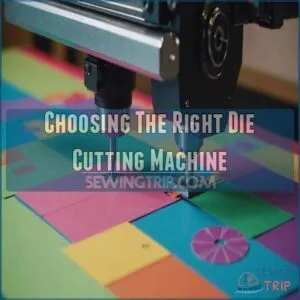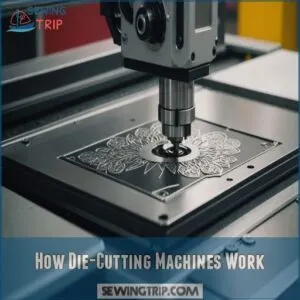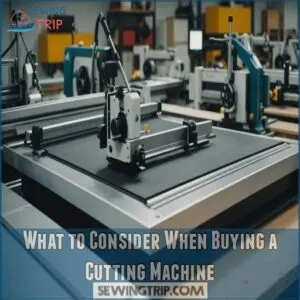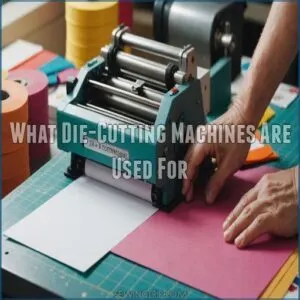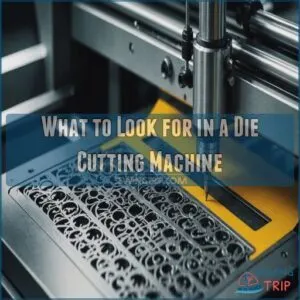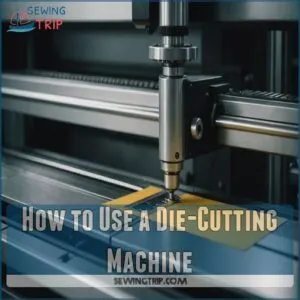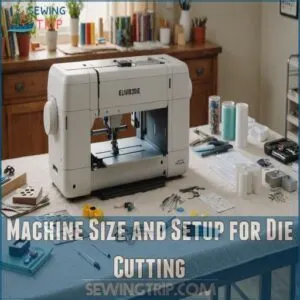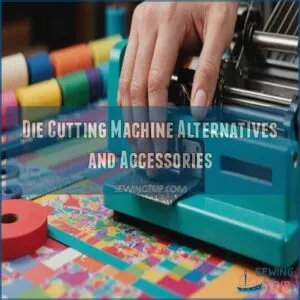This site is supported by our readers. We may earn a commission, at no cost to you, if you purchase through links.
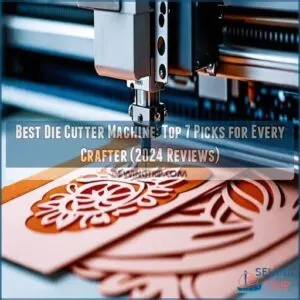
From manual to electronic options, you’ll find a wide range of choices to suit your needs.
Consider factors like cutting size, material compatibility, and portability when making your decision.
Popular brands like Sizzix, Cricut, and Silhouette offer excellent machines with varying features.
Remember, the best machine for you depends on your specific projects and budget.
With the right die cutter, you’ll be cutting, embossing, and creating intricate designs like a pro in no time.
Stick around to discover which machines made our top 7 list and why.
Table Of Contents
- Key Takeaways
- Choosing The Right Die-Cutting Machine
- How Die-Cutting Machines Work
- What to Consider When Buying a Cutting Machine
- What Die-Cutting Machines Are Used For
- Top 7 Best Die Cutter Machines
- What to Look for in a Die Cutting Machine
- How to Use a Die-Cutting Machine
- Machine Size and Setup for Die Cutting
- Die Cutting Machine Alternatives and Accessories
- Frequently Asked Questions (FAQs)
- Conclusion
Key Takeaways
- You’ll find the Gemini II as the top choice for its large 9" x 12.5" platform and powerful cutting capability, though it’s heavier at 20.5 pounds compared to other options.
- You can use manual machines like the Sizzix Big Shot for basic crafting needs, while electronic cutters like the Silhouette Cameo 4 offer digital design capabilities and wider material compatibility.
- You’ll need to consider cutting force (4-5kg), material compatibility, and software interface when choosing your machine—factors that directly impact what projects you can tackle.
- You don’t need a subscription or printer to start using most die cutters, though having a computer will give you more design flexibility and creative options.
Choosing The Right Die-Cutting Machine
You’ll need to think about key factors like cutting size, material compatibility, and budget when selecting your perfect die-cutting machine.
Whether you’re planning to create intricate paper designs or work with thick materials like leather, the right machine will match your crafting needs while fitting comfortably in your workspace.
Cutting Size and Material Compatibility
When you’re eyeing a die-cutting machine, cutting size and material compatibility should top your checklist.
Most machines handle standard materials like paper and vinyl, but if you’re planning to work with leather or balsa wood, you’ll need a powerhouse like the Cricut Maker.
Check the maximum cutting width – standard 12-inch platforms work for most projects, while compact 6-inch machines suit cardmaking.
Portability and Dimensions for Storage
After considering cutting size, let’s talk about fitting your die-cutting machine into your life—literally.
Regarding storage and portability, size matters.
You’ll want to weigh these factors:
- Machine footprint
- Weight for easy transport
- Folding or collapsible features
- Storage accessories like cases or covers
Remember, a bulky machine that’s always in the way might dampen your creative spark.
Opt for a compact design that won’t cramp your style or your workspace.
Cutting Plates and Accessories for Versatility
The heart of your die-cutting machine’s versatility lies in its cutting plates and accessories.
You’ll want to think about the range of die types and materials you can use.
Look for machines that offer a variety of plate sizes and thicknesses to accommodate different projects.
Some brands, like Sizzix and Spellbinders, are known for their wide selection of compatible dies and accessories, giving you more creative freedom.
Price and Cost-Effectiveness
You’re probably wondering about the price tag on these nifty machines.
Let’s break down the cost-effectiveness of die cutters:
- Initial investment vs. long-term savings
- Budget-friendly options for beginners
- High-end machines with advanced features
- Consumables and replacement parts
- Return on investment for frequent crafters
When comparing prices, consider not just the upfront cost but also the value you’ll get over time.
Some budget options offer great bang for your buck, while pricier models might be worth it for serious crafters.
Durability and Reliability for Long-Term Use
For long-term use, your die-cutting machine’s durability is vital.
A sturdy workhorse can save you money and frustration down the road.
Let’s break down key factors to keep in mind:
| Factor | High Durability | Low Durability |
|---|---|---|
| Build Quality | Solid metal frame | Plastic components |
| Motor | Heavy-duty | Lightweight |
| Brand Reputation | Established, positive | New or mixed reviews |
| Warranty | Extended coverage | Limited or none |
Remember, a reliable machine means less downtime and more crafting joy.
Don’t skimp on quality if you plan to use it frequently.
How Die-Cutting Machines Work
Ever wondered how die-cutting machines transform a flat sheet into intricate designs? These crafty devices work their magic through a combination of pressure and precision. Here’s a quick rundown of how they operate:
- Cutting mechanism: Uses sharp dies or blades to slice through materials
- Pressure application: Applies force to push the die through the material
- Die types: Can be flat metal shapes or digital designs for electronic cutters
- Material feed: Guides the material through the machine for accurate cutting
- Ejection system: Removes the cut pieces from the die or cutting area
You’ll find that die-cutting machines come in manual, electric, and electronic varieties. Each type uses a different method to apply pressure and control the cutting process.
The beauty of these machines lies in their versatility – they can handle everything from paper to fabric, depending on the model. It’s like having a personal factory for your crafting needs!
What to Consider When Buying a Cutting Machine
When you’re in the market for a cutting machine, you’ll need to think about how you’ll use it, what software it requires, and how much space you have available.
These factors will help you choose the right machine that fits your crafting needs and workspace, ensuring you get the most out of your investment.
How Will You Use The Machine
Before picking a die-cutting machine, think about your crafting goals.
Are you into scrapbooking, card making, or quilting? Maybe you’re eyeing custom gifts or home decor projects? Or perhaps you’re launching a small business?
Your machine’s capabilities should align with your ambitions.
Consider the key features to look for, such as cutting power and material compatibility.
Consider the materials you’ll work with most – paper, vinyl, fabric, or even wood. This’ll help you narrow down your options and find your perfect crafting companion.
What Software Does It Use
Software compatibility is important when choosing a die-cutting machine.
Most machines come with their own design software, each with unique features and learning curves.
Consider these key factors:
- User-friendliness
- Design capabilities
- File format compatibility
- Integration with other software
Cricut Design Space and Silhouette Studio are popular options, offering different levels of complexity.
Remember, you’ll be spending a lot of time with this software, so choose one that aligns with your skill level and creative needs.
How Much Space Do You Have for The Machine
When considering a die-cutting machine, size matters.
Your craft room’s space dictates your options.
Measure your workspace and compare it to machine dimensions.
For tight quarters, look into compact models like the Cricut Joy.
If you’ve got room to spare, larger machines offer more cutting options.
Don’t forget to factor in storage solutions for your machine and accessories when it’s not in use.
What Die-Cutting Machines Are Used For
Die-cutting machines are versatile tools that can transform your crafting projects, from quilting and scrapbooking to creating custom decals and home decor.
You’ll find these machines indispensable for cutting intricate designs in various materials, including fabric, paper, and vinyl.
Die-cutting machines open up a world of creative possibilities for both hobbyists and professional crafters alike.
Quilts and Fabric Crafts
Die-cutting machines are game-changers for quilters and fabric crafters.
You’ll love how they slice through multiple layers of fabric like butter, saving you time and effort.
Whether you’re working on a patchwork quilt top, learning more about the differences between patchwork and quilting can help you create a cohesive look, or whipping up intricate quilt blocks or crafting fabric appliques, these machines are your new best friend.
With tools like the Accuquilt Go, you can cut perfect shapes every time, and by using specialized sewing machine feet, such as an invisible zipper foot, you can easily tackle a variety of sewing projects, making your quilting projects a breeze.
Stencils and T-Shirt Design
Moving from quilting to custom apparel, die-cutting machines are a game-changer for stencils and t-shirt design.
You’ll love creating unique vinyl transfers or intricate stencils for fabric paint.
With machines like the Cricut Maker, Cricut Explore Air 2, or Silhouette Cameo 4, you can easily cut heat transfer vinyl for professional-looking t-shirts.
These versatile tools let you bring your designs to life, whether you’re crafting for yourself or starting a small business.
Scrapbooking and Homemade Cards
For scrapbookers and card makers, die-cutting machines are game-changers.
They open up a world of creative possibilities, letting you craft stunning personalized cards and scrapbook pages with ease.
Here’s how they elevate your paper crafting:
- Precise cuts for intricate designs
- Consistent shapes for layering techniques
- Time-saving for mass-producing cards
- Versatile options for various cardstock types
- Custom embellishments to match any theme
With the right machine, you’ll be churning out professional-looking projects in no time, impressing friends and family with your crafting prowess.
Decals, Stickers, and Magnet Designs
After mastering cards and scrapbooks, you’re ready to tackle decals, stickers, and magnets.
Your die-cutting machine is a powerhouse for these projects.
With the help of a versatile sticker cutting machine, you can take your crafts to the next level.
Whether you’re whipping up vinyl decals for your car or creating custom stickers for your planner, the possibilities are endless.
With machines like the Cricut Maker or Silhouette Cameo 4, you can cut intricate designs on various materials, including magnet sheets.
It’s like having a mini factory at your fingertips!
Home Decor and Other Creative Projects
With die-cutting machines, you can elevate your home decor game.
Create custom wall art, personalized accents, and unique paper crafts to spruce up any room.
Want to make a statement? Craft intricate window treatments or customized lampshades.
These versatile tools also let you whip up one-of-a-kind gifts for friends and family.
From seasonal decorations to DIY projects, your creativity is the only limit.
Top 7 Best Die Cutter Machines
You’re about to discover the cream of the crop in die-cutting machines, with options to suit every crafter’s needs and budget.
From the versatile Gemini II to the compact Mini Die Cutting Embossing Machine Combo, these top 7 picks offer a range of features and capabilities to elevate your crafting game.
1. Gemini II Die Cutter Embosser
The Gemini II Die Cutter Embosser stands out as a powerhouse in the craft room.
You’ll love its large 9" x 12.5" platform, which easily handles multiple dies at once – perfect for batch-making those holiday cards.
It’s faster and quieter than most competitors, though at 20.5 pounds, you won’t be moving it often.
While it excels with thin metal dies and embossing folders, it might struggle with intricate designs on thick cardstock.
The pause and reverse functions are lifesavers when you need to adjust mid-cut.
Best For: Crafters who want a fast, efficient, and powerful die-cutting and embossing machine with a large platform.
- Large platform for cutting multiple dies at once
- Fast and quiet operation
- Pause, resume, and reverse plate functionality
- Heavy weight
- May struggle with intricate dies on thick cardstock
- Requires proper care and maintenance to extend plate lifespan
2. Spellbinders Platinum Die Cutting Machine
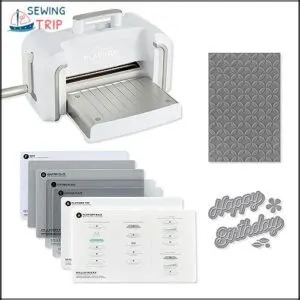
Standing proud as a versatile champion, Spellbinders Platinum delivers precise cuts and embossing with its XL Universal Plate System.
You’ll appreciate its compatibility with various dies, including steel rule and wafer-thin templates, while the 3D embossing folder adds creative depth to your projects.
For the best results, consider exploring a range of die cutting machines and accessories online at Die Cutting Machines.
It’s compact enough to fold away when in use, yet powerful enough to cut through eight layers of paper simultaneously.
While you might need to experiment with different sandwich combinations for the best outcome, its smooth operation and wide material compatibility make it worth the learning curve.
Best For: Crafters and hobbyists who love to experiment with different dies and materials and want a machine that can handle a variety of projects.
- Offers smooth and precise cuts with a variety of dies and materials.
- Cuts up to eight layers of paper at once.
- Compact and easy to store.
- May require trial and error with intricate dies from different manufacturers.
- May require shimming for clean cuts with intricate dies.
- Cutting plates are consumables and may need to be replaced.
3. Sizzix Big Shot Manual Die 6 Inch
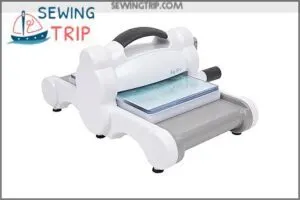
Built like a tank, the Sizzix Big Shot Manual Die 6 Inch machine proves itself as a reliable workhorse for your crafting adventures.
You’ll appreciate its versatility, handling everything from paper to thin metal with precision.
An A5-sized opening accommodates most creative projects, while the improved platform design makes operation a breeze.
Despite its 7.5-pound weight, you’ll find it worth every penny for card making, scrapbooking, and quilting projects.
Plus, it’s compatible with the entire Sizzix library (except Plus and Pro dies), giving you endless creative possibilities.
Best For: The Sizzix Big Shot Manual Die 6 Inch is best for crafters who want a durable machine for a wide range of projects.
- Durable construction for long-lasting use.
- Versatility for various crafting projects.
- Compatibility with a vast library of dies.
- May be too large for some users.
- Not suitable for dies wider than 6 inches.
- Assembly required for the handle of the lever.
4. AccuQuilt GO Fabric Cutter Starter Set
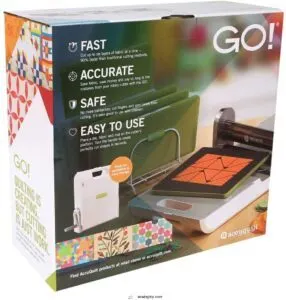
You’ll appreciate how the AccuQuilt GO Fabric Cutter transforms your quilting projects with its impressive speed, cutting fabric up to 90% faster than traditional methods.
This portable die-cast aluminum cutter handles multiple layers simultaneously – up to 6 layers of flannel, 8 of cotton, or 2 of fleece.
While the initial investment and die costs might seem steep, the precision and time savings make it worthwhile.
The starter set includes everything you need: a die, cutting mat, die pick, and pattern book.
Just remember to rotate your cutting mats regularly for extended life.
Best For: Quilters and crafters looking for a fast and accurate way to cut fabric.
- With rotary cutters like the Fiskars 60mm Titanium Rotary Cutter offering advanced blade safety features, cuts fabric up to 90% faster than scissors or rotary cutting.
- Easy to use and includes everything you need to get started.
- Multiple dies available for different shapes and sizes.
- Initial investment and die costs can be high.
- Cutting mats need to be replaced periodically.
- Fabric waste can occur due to the die design.
5. Sizzix Big Shot Switch Plus Die Cutting Machine
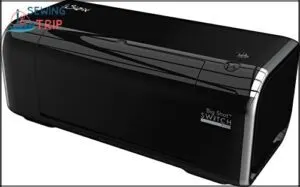
While the Sizzix Big Shot Switch Plus brings modern flair with its glossy black design and chrome accents, it’s the two-button system that really shines.
You’ll appreciate the 9-inch opening that handles A4-sized materials and the automatic feed that makes crafting smoother than ever.
A handy compartment keeps your tools and dies organized, though the plastic components mightn’t match the durability of older models.
It’s compatible with various Sizzix technologies, including Bigz dies, but consider the higher price point and occasional customer service delays before investing.
Best For: Crafters who want an easier, more automated die-cutting experience with a stylish machine.
- Automatic feed and reverse feature for smoother operation
- 9-inch opening for A4-sized materials
- Stylish design with chrome accents
- Higher price point compared to other models
- Plastic components may not be as durable as previous models
- Customer service response time may be slow
6. Mini Die Cutting Embossing Machine Combo
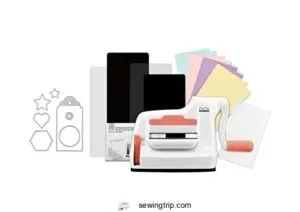
The Bira Craft Mini Die Cutting Machine offers an excellent alternative to the Cricut Explore 3, which is a mid-range option that offers a balance of functionality and affordability, making it ideal for crafters and DIY enthusiasts looking for a versatile and affordable cutting machine, like the best cricuts. The Bira Craft Mini Die Cutting Machine packs powerful performance into a compact 3.75 x 8.25-inch frame.
Its versatile design works seamlessly with leading brand dies and embossing folders through a 3-inch opening.
You’ll appreciate the thorough starter kit, which includes plates, dies, and pre-cut cardstock.
The machine excels at detailed cuts and dry embossing, though you might need paper shims for 3D folders.
While the suction cup base occasionally needs cleaning for the best grip, the efficient cutting action and stellar customer service make this an excellent budget-friendly choice.
Best For: Crafters on a budget who want a simple, compact machine for cutting and embossing.
- Cuts well, even detailed dies.
- Dry embossing works better than other machines.
- Affordable and easy to use.
- Suction cup doesn’t always hold securely.
- C plate can get cut up.
- Narrow feed limits use of embossing folders.
7. Silhouette Cameo 4 Starter Bundle
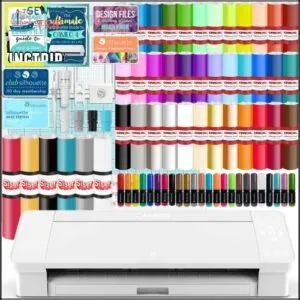
Powerhouse crafting meets user-friendly design in the Silhouette Cameo 4 Starter Bundle.
It’s equipped with a roll holder feeder for paper and vinyl rolls, plus you can cut without a mat – perfect for tackling larger projects.
Though the machine runs loud, its cutting precision and versatility make up for the noise.
You’ll get a variety of supplies right out of the box, including vinyl and heat transfer materials.
The software has a learning curve, but many crafters find it more intuitive than Cricut’s platform once they’ve mastered it.
Best For: This bundle is perfect for both beginners and experienced crafters looking to explore a powerful cutting machine with a variety of features.
- Includes a variety of supplies to get you started.
- Can cut without a mat, making it suitable for larger projects.
- Offers a different design space than Cricut, which some users find more user-friendly.
- The machine can be quite loud.
- The included supplies may not be of the highest quality.
- The software can be difficult to learn at first.
What to Look for in a Die Cutting Machine
You’ll want to understand the key features that make a die cutting machine worth your investment, from cutting force to software compatibility.
When you’re spending hundreds of dollars on a crafting tool, it’s important to match the machine’s capabilities with your specific needs and creative goals.
Cutting Force and Material Compatibility
Understanding cutting force and material compatibility helps you pick a die-cutting machine that’ll handle your projects with ease.
You’ll want a machine that matches your crafting ambitions.
Here’s what makes a die-cutting machine truly versatile:
- Cutting force between 4kg (Cricut Maker) to 5kg (Silhouette Cameo 4)
- Material thickness capacity up to 3/36 inches
- Blade sharpness for clean, precise cuts
- Pressure control settings for delicate materials
- Die quality for consistent results
Ease of Use and User Interface
When choosing your die-cutting machine, you’ll want to focus on how easy it’s to navigate the software and physical controls.
Most modern machines like the Cricut Maker and Silhouette Cameo 4 offer user-friendly interfaces with clear instructions and tutorials.
For instance, the Cricut Explore Air 2 Machine Review highlights the importance of a SmartSet dial for material settings, which can greatly enhance the user experience.
Look for machines with intuitive design tools, touch screens, and mobile compatibility.
Consider the learning curve – some software’s steeper learning curve pays off with greater customization options.
Additional Features and Accessories
Beyond basic cutting features, great die-cutting machines come packed with useful extras.
Look for machines offering specialized blade types for different materials, scoring tools for clean folds, and embossing dies for added texture.
You’ll want several cutting mats to handle various projects, and don’t forget cutting plates – they’re like insurance for your machine’s longevity.
Quality accessories let you tackle more creative projects with confidence.
Brand Reputation and Customer Support
A reliable brand and strong support system can make or break your crafting experience.
Here’s what top brands like Cricut and Silhouette offer:
- Active community forums where crafters share tips and troubleshooting advice
- Extensive warranty options that protect your investment
- Responsive customer service teams available through multiple channels
Check recent service reviews and observe how companies handle complaints before making your choice.
Remember, a brand’s reputation often reflects the overall experience you’ll have.
How to Use a Die-Cutting Machine
You’ll find that using a die-cutting machine isn’t as complicated as it might seem at first glance, as these versatile tools come with straightforward controls and clear instructions.
Whether you’re a beginner or an experienced crafter, understanding the basic steps of die cutting will help you create precise, professional-looking cuts for your projects.
Parts of The Machine and Their Functions
Getting familiar with your die cutting machine’s components is like learning the parts of a car – each piece serves a vital purpose. Just as understanding how a sewing machine’s needle and feed dogs work together sewing machine components can improve your sewing, knowing your die cutter’s parts can elevate your crafting skills.
The base plate acts as your foundation, while the pressure plate applies even force across your materials.
Your blade holder keeps cutting dies secure, and adjustment knobs let you fine-tune the pressure for different materials’ thickness.
How to Cut With a Die-Cut Machine
Now that you know the machine’s parts, let’s get your first cut started.
Place your chosen material on the cutting mat, aligning it carefully within the guidelines.
Sandwich your material and die between the cutting plates – think of it like making the world’s craftiest PB&J.
Once everything’s lined up, feed it through your machine’s rollers with steady, even pressure.
Tips for Getting The Best Results
After mastering the basic cutting steps, you’ll want to fine-tune your technique for perfect results.
Start with fresh cutting plates to avoid uneven pressure.
Keep your dies organized and clean – a magnetic sheet works wonders.
Test cuts on scrap material first, and don’t forget to maintain proper blade depth.
Regular machine cleaning and calibration will help you avoid those frustrating miscuts.
Machine Size and Setup for Die Cutting
You’ll need to understand your machine’s size requirements and setup process before choosing the perfect spot in your crafting area.
Modern die-cutting machines like the Silhouette Cameo and Cricut Maker need about 24 inches of counter space, plus room for your computer or tablet during setup.
Space Requirements for The Machine
You’ll need to think about both the machine’s footprint and your workspace size before bringing home a die-cutting machine.
Most popular models, like the Cricut Maker and Silhouette Cameo, require at least 24 inches of countertop width.
If you’re tight on space, compact options like the Cricut Joy or Sizzix Big Shot offer smaller footprints while still delivering impressive cutting capabilities.
Setting Up The Machine for Use
Setting up your die-cutting machine isn’t rocket science, but it’s worth taking a few minutes to get it right.
Start by finding a flat, stable surface with good lighting.
Plug in your machine and install any necessary tools or blades.
Most modern machines have user-friendly interfaces, guiding you through the calibration process.
Don’t forget to download and install the required software on your computer or smartphone for seamless design creation and cutting.
Storage Options for The Machine
Finding the perfect home for your die-cutting machine doesn’t have to be a headache.
If you’re looking for more in-depth storage solutions, consider investing in a best sewing cabinets for home.
Whether you’re short on space or blessed with room to spare, there’s a storage solution for you.
From compact shelving units to DIY pegboard organizers, you’ve got options.
Consider rolling carts for portability or dedicate a cozy corner of your crafting area.
Remember, easy access is key for frequent use.
Die Cutting Machine Alternatives and Accessories
You’ll find more than just die cutters to fuel your crafting passion.
Electronic cutting machines and user-friendly design software offer versatile alternatives.
A range of accessories can enhance your die cutting machine’s functionality and expand your creative possibilities, such as custom die cuts for creative die cutting projects like handmade going away cards and other mixed media techniques.
Electronic Cutting Machines and Their Benefits
Electronic cutting machines offer a world of possibilities beyond traditional die cutters.
They bring design flexibility and material versatility to your crafting table.
For example, using machines like the Sizzix Big Shot Pro can provide an industrial strength construction suitable for cutting wider materials.
Here are four key benefits:
- Endless design options with digital files
- Ability to cut a wider range of materials
- Precision cutting for intricate designs
- Cost-effective for frequent crafters
With machines like the Cricut Maker, Silhouette Cameo 4, and Cricut Explore Air 2, you’ll expand your creative potential and tackle a variety of projects with ease.
User-Friendly Software for Design and Cutting
The digital world of die-cutting software opens up a world of creative possibilities.
You’ll find user-friendly options like Cricut Design Space, where you can even find related products and accessories at Cricut Design Space products, and Silhouette Studio that make designing a breeze.
These programs offer intuitive interfaces, pre-made templates, and learning resources to help you master the craft.
Compare features, read user reviews, and consider your skill level when choosing.
Whether you’re a newbie or a pro, there’s software suited to your needs.
Additional Accessories for Enhanced Functionality
To amp up your die-cutting game, you’ll want to explore a range of accessories. Custom dies let you create unique shapes, while embossing plates add texture to your projects.
Don’t forget scoring tools for perfect folds and pen holders for adding personalized touches.
Cutting mats protect your work surface, and a variety of blades tackle different materials.
A rotary tool and scoring wheel can take your crafting to the next level.
Frequently Asked Questions (FAQs)
Does Cricut require a subscription?
Ah, the age-old question: to subscribe or not to subscribe?
Cricut doesn’t require a subscription, but they offer one.
You can use the machine without it, though some fancy features and designs might be off-limits.
Your call, crafty friend!
Is it worth paying more for a Cricut or a Silhouette machine?
Choosing between Cricut and Silhouette depends on your needs.
Cricut’s user-friendly interface suits beginners, while Silhouette offers more customization for advanced users.
Consider your projects, budget, and desired features to determine if the higher price is worth it for you.
Do you need a printer to use a Cricut machine?
You don’t need a printer for most Cricut projects.
Your machine cuts designs directly.
However, for Print Then Cut features, you’ll want a printer.
It’s not essential but can expand your creative possibilities.
Do I need a computer to use a vinyl-cutting machine?
Most vinyl-cutting machines require a computer for design work and operation.
However, some models, like the Brother ScanNCut, have built-in screens and can function independently.
You’ll have more flexibility with a computer, but it’s not always essential.
How difficult is it to set up a software-based machine?
Setting up a software-based cutting machine isn’t rocket science.
You’ll need to install the software, connect your machine, and follow the prompts.
It’s like setting up a new printer – a bit of patience goes a long way.
How much do online templates cost to download?
Prepare for a wallet-friendly adventure!
Online templates for die-cutting machines vary wildly in price.
You’ll find free options, but premium designs can cost $99 to $5 each.
Many brands offer subscription plans for unlimited access.
Are die cutting machines safe for children to use?
Die cutting machines can be safe for children, but supervision is essential.
You’ll want to choose models with safety features and teach proper handling.
Start with kid-friendly options and always prioritize safety over complexity.
What is the difference between Cricut and Sizzix?
In terms of cutting-edge crafting, Cricut and Sizzix are apples and oranges.
Cricut offers digital, versatile machines for various materials, while Sizzix specializes in manual die-cutting, excelling with paper and fabric.
Your choice depends on your crafting needs.
Is a Cricut the same as a die cut machine?
A Cricut is a type of die cut machine, but not all die cut machines are Cricuts.
Cricut’s a brand that makes electronic cutting machines, while die cutters can be manual, electric, or electronic like Cricut’s devices.
What are the disadvantages of a die cutter?
You’ll face some drawbacks with die cutters.
They require sharp tools.
They need new dies for each design.
They can be pricey.
Plus, they’re limited to specific materials and sizes, potentially restricting your creative freedom.
What is the difference between the Gemini and the Gemini Junior?
The main difference lies in size.
The Gemini is larger, accommodating wider dies and materials up to 12 inches.
The Gemini Junior, more compact and portable, handles materials up to 6 inches wide.
Both offer similar cutting performance.
Can die-cutting machines cut multiple layers simultaneously?
Picture layers of fabric stacked like a colorful sandwich.
Die-cutting machines can slice through multiple layers simultaneously.
You’ll save time and effort, creating intricate designs with precision.
It’s like magic for crafters seeking efficiency.
How often should die-cutting machine blades be replaced?
Replacing die-cutting machine blades depends on usage and material thickness.
Generally, you’ll notice when cuts become less precise.
For most hobbyists, changing blades every 3-6 months is a good rule of thumb.
Always keep spares handy!
Are die-cutting machines noisy during operation?
Most die-cutting machines operate quietly, with electronic models producing a gentle hum.
Manual machines are nearly silent, while automatic ones might make moderate mechanical sounds – nothing that’ll wake the neighbors or disturb conversations.
Can die-cutting machines work with unconventional materials?
While you might think die-cutters only handle paper, modern machines like the Cricut Maker and Silhouette Cameo 4 can tackle surprising materials.
Do die-cutting machines require special maintenance or cleaning?
You’ll need to clean your die-cutting machine regularly with a soft brush and compressed air.
Lubricating moving parts annually and replacing worn cutting mats keeps your machine running smoothly and extends its lifespan.
Conclusion
Just like a trusty typewriter of yesteryear, finding the best die cutter machine requires careful consideration of your needs and budget.
We’ve guided you through the top options, from the versatile Gemini II to the compact Sizzix Big Shot.
Whether you’re crafting cards, quilts, or custom decals, there’s a perfect machine waiting for you.
Remember to weigh factors like cutting size, material compatibility, and portability.
With this guide, you’re ready to make an informed choice and start creating amazing projects.

